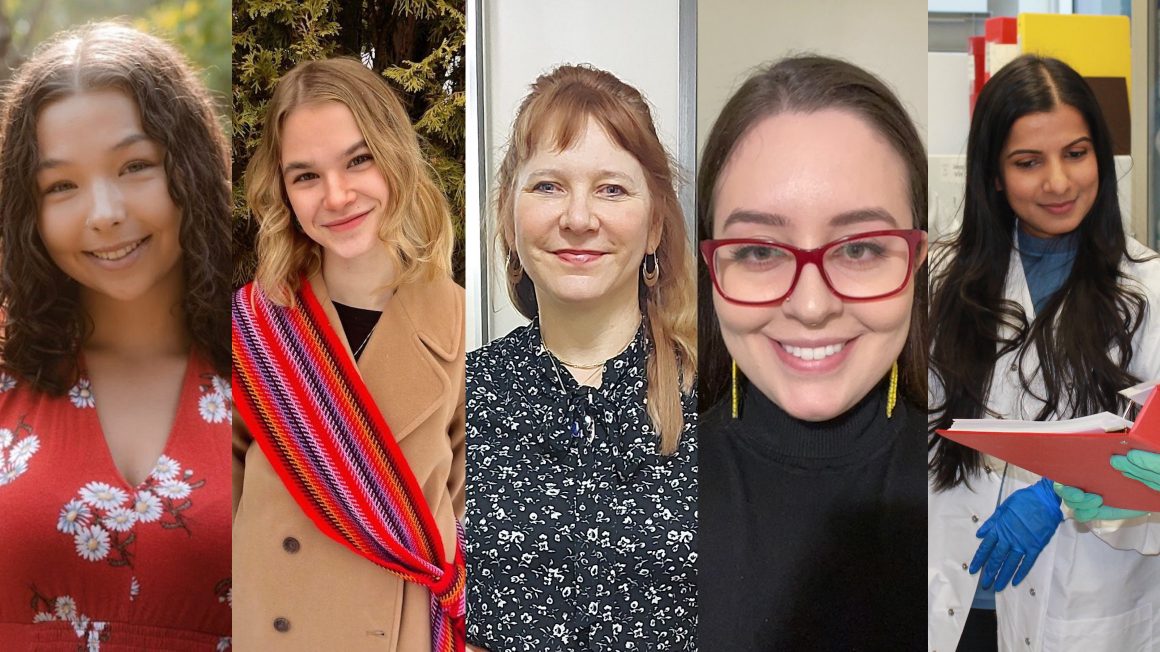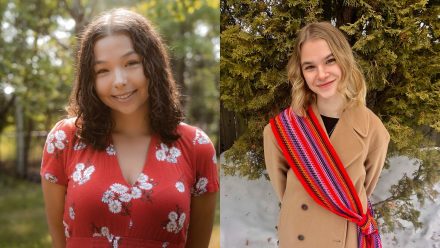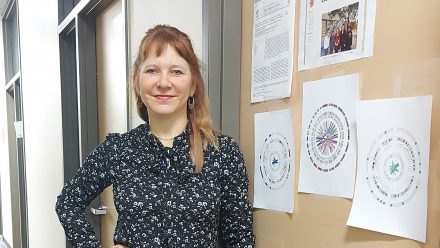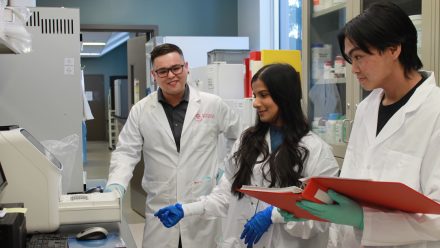Throughout the year, we share many stories celebrating the achievements of women in science. In celebration of International Day of Women and Girls in Science, we are proud to highlight stories of students and faculty members like Cassidy Lamirande, Gracie Grift, Dr. Sara Good, Monalisa Abas, and Dr. Sanoji Wijenayake, all of whom are doing incredible work in their fields.
Cassidy Lamirande and Gracie Grift
As leaders of the UWinnipeg Chapter of the Canadian Indigenous Science and Engineering Society (.caISES), President Cassidy Lamirande and Vice-President Gracie Grift are hoping to make science more accessible for Indigenous students.
Their hard work was recognized this past fall when they were awarded the .caISES Chapter Development Award, which is given to a chapter that “ensures that upon graduation, their members are prepared to enter the workforce.”
“It’s nice to know we’re being recognized, because sometimes you’re not always sure how much the work you do means to people,” Lamirande, who’s majoring in neuroscience, said. “It also goes to show how much work we’ve put in (to the club).”
Lamirande learned about the chapter while studying white-nose syndrome in bats with Dr. Craig Willis in the Pathways to Graduate Studies program, while Grift learned about .caISES from Josh Swain, who is a McCall MacBain Scholar and former .caISES Vice-President, when he visited her first-year chemistry class.
Both have been involved ever since their introduction to the chapter.
“I’ve always been involved in extracurriculars,” Grift, who’s in her third year of biology studies, explained. “This was my time to meet other people who are in science, especially Indigenous science students, because we really didn’t have any sort of group like that at my high school.”
Dr. Sara Good
Dr. Sara Good, Professor in the Department of Biology, is part of a team of researchers whose recent findings have the potential to play a pivotal role in the future of Great Lakes fisheries by assisting in the control of sea lamprey populations.
Results published in Nature Communications Biology, as part of the paper Pervasive male-biased expression throughout the germline-specific regions of the sea lamprey genome supports key roles in sex differentiation and spermatogenesis, suggest there has been significant progress made in uncovering the processes of sex differentiation, testicular development, and possibly sex determination.
“There’s been a real growth in our understanding of the diversity of the mechanisms that vertebrates use to determine sex,” said Dr. Good. “That has exploded because of all the new molecular methods over the last 10 years. We don’t know the mechanism of sex determination in lamprey yet, but this paper gave clear evidence that we’re on the trail of finding what that mechanism could be.”
Dr. Good, who’s currently applying for more funding to dig deeper into the research, wants next to sequence the genome of the female gonad and continue the pursuit of finding the genes which play a role in sex determination.
Monalisa Abas
Monalisa Abas is passionate about making science more accessible to the next generation of students.
Abas, who has been a member of the campus community for as long as she can remember, is a graduate of the UWinnipeg Collegiate, completed a four-year Bachelor of Science in Biochemistry in 2020, and is now studying in the Master of Science in Bioscience, Technology, and Public Policy program.
After learning about Science Rendezvous, which is Canada’s largest science festival, from Dr. Tabitha Wood last year, she decided to volunteer her time for the annual event.
“Dr. Wood approached me with this idea she had for a video we could do where we would make a bowl of popcorn, pour some melted butter on it, come back to it later, and realize that the butter has solidified the popcorn,” she explained. “At the end of the video we ask, ‘what is the effect of lowering the temperature below the butters melting point?’”
Abas says she loved the video idea because it was a simple illustration of chemistry that’s easy to understand. While creating and editing the video was both fun and stressful, she became a master of iMovie in only a few days.
And it’s that type of fun science, she explained, that makes Science Rendezvous such “an awesome event.”
Dr. Sanoji Wijenayake
Dr. Sanoji Wijenayake, Assistant Professor in the Department of Biology, received a 2022 Manitoba Medical Service Foundation Operating Grant to research the neurodevelopmental effects of maternal obesity exposure and to also characterize the functional roles of milk exosomes, a new class of nanovesicles abundant in mammalian milk.
The main objective of her work is to characterize the role of maternal milk as a biological regulator of early postnatal development and growth. Her lab is using cell culture techniques, an obesity-centric rodent model, microscopy, advanced molecular and biochemistry toolkits, and Next Generation Sequencing technologies.
“A lot of a baby’s immune system at the very beginning of life comes straight from the mom’s milk,” she explained. “Milk also contains hormones and growth factors that are tailored for different stages of development, and a complex microbiome that helps establish baby’s gut.”
Recently, a group of small, fat-coated nanovesicles, known as milk-derived exosomes, were discovered in breastmilk. This is one of the main things Dr. Wijenayake is studying.
“These tiny nanovesicles transport nucleic acids (microRNAs), small proteins, enzymes, and fats from mothers to their offspring during feeding. They are also extremely stable, survive digestion, and are excellent at migrating across complex cell barriers, including the gut lining and the blood brain barrier,” she explained.
International Day of Women and Girls in Science takes place every year on February 11. Join the conversation by following the hashtags #WomeninScienceDay, #GirlsNeedRoleModels, and #WomenInSTEM.







